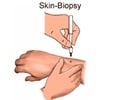Classification of Leprosy and the clinical symptoms
Leprosy is classified into several types based on the bacterial load present in the lesions, the extent of skin and nerve involvement and based on the presence of deformities. Several types of classification like Madrid classification, Ridley & Jopling classification Indian Classification, WHO classification , Field Worker's Classification etc.
Based on the 2 commonly used classifications, leprosy is classified into six types based on the clinical features (Ridley & Jopling classification):
The type of the disease is a reflection of the immune status of the host.
The first sign of the disease is the feeling of numbness or loss of sensation for temperature (heat) followed by touch and pain which usually begins at the extremities. The skin lesions appear later during the course of the disease.
| Disease | Clinical Features |
| Indeterminate leprosy | They are the first type of skin lesions characterized by hypo-pigmented spots The lesions undergo healing spontaneously |
| Paucibacillary (tuberculoid leprosy) | A large red patch with well-defined raised borders or a large hypo pigmented asymmetrical lesion. Lesion is dry and hairless Infectivity is minimal at this stage Loss of sensation is seen Nerves become thick followed by loss of function It either progresses to the borderline stage or spontaneously get cured |
| Borderline borderline leprosy | Characterized by small and numerous skin lesions The disease goes back to the tuberculoid stage or progresses to the next stage |
| Borderline borderline leprosy | Several small, irregular red lesions are seen Moderate sensory loss is seen It either goes back to the previous stage or progresses to the next |
| Borderline lepromatous leprosy | Several lesions such as plaques, macules, papules, and nodules are seen Lesions have a characteristic inverted saucer like appearance |
| Multibacillary Hansen’s disease (lepromatous leprosy) | Early symptoms: Several lesions such as plaques, macules, papules, and nodules are seen Nasal congestion, discharge and bleeding is seen Inflammation of the leg and ankles Progressive symptoms: Thickening of the dermis (skin) in the forehead and ear lobes Loss of eyebrows and eyelashes Eye defects such as glaucoma and blindness are seen Nodules in the legs break and form ulcers Enlargement of the breast and sterility occurs in the males Internal infection results in the enlargement of the liver and lymph nodes Loss of sensation in the peripheral nerves. Deformation of the fingers and toes results due to painless repeated trauma |
The Indian classification has an additional type, the neuritic type, which is bacteriologically negative and shows neural involvement without any skin lesions.











